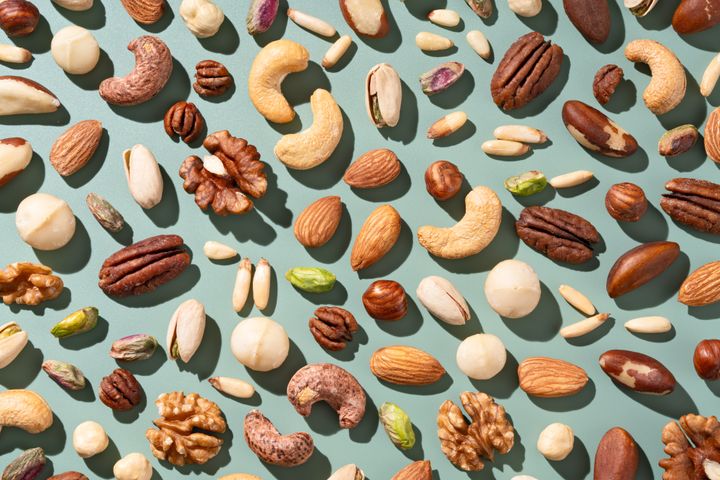
When people want a healthy snack, they tend to reach for nuts — if they can afford them.
At many grocery stores, nuts cost a lot more than a bag of chips. For instance, Walmart sells a 15.25-ounce container of mixed nuts for $8.98. At airports, a bag of trail mix gets priced at $6 a bag, but a bag of Combos might only be $3. Why are nuts so expensive?
“Tree nuts can take years, if not decades, to mature into a harvestable crop,” food scientist and food industry consultant Bryan Quoc Le told HuffPost. “Many of the high-cost nuts, such as macadamia or cashew nuts, require manual labor to separate from the tree. They may also be sorted and graded by hand, which adds additional costs. With fresh nuts, harvest only happens once a year and needs to be processed, distributed and sold within weeks of harvest to achieve peak flavor.”
Other factors like climate change, droughts and wildfires contribute to the high cost of tree nuts. California produces 80% of the world’s almonds, but one almond uses 3.2 gallons of water to reach maturation. Costco sells half of the world’s cashews, and they sell them at a fairly reasonable price of $6 per pound.
“Larger cashews that are unblemished, unbroken and lightly roasted are more expensive,” explained Joshua Reed-Diawuoh, the owner of GRIA Food Co., a Fairtrade African snack company. “Smaller cashews that have been scorched during processing due to a longer roasting are less expensive. Small cashew pieces are usually the least expensive. Larger cashews have a distinctive and richer taste than smaller kernels and are visually more appealing to many consumers. The quality will also depend on how fresh they are, the storage conditions, and cashew processing steps.”
Dietitian Angel Luk said the macadamia nut is the most expensive nut in the world to grow. “It takes seven to 10 years for the trees to simply start to produce nuts, let alone mature for a substantial harvest,” she told HuffPost. A pound of macadamia nuts can cost as much as $25.
Tejal Parekh, a registered and licensed dietitian, explained that low supply and high demand make nuts more expensive. “Pine nuts are one of the most costly nuts on the market,” she said, and pine nuts — used in pesto — can be challenging to extract.
Some nuts are simply priced higher because of their flavor and exclusivity, like Marcona almonds, which have a buttery flavor. “Marcona almonds are a sweeter, softer variety of almonds that grow exclusively in the Mediterranean coast of Spain,” she said. “Because of this exclusivity, they are costly.”

Why are peanuts so cheap, then?
Prepare yourself: peanuts aren’t a nut. They’re a bean and part of the legume family, and they’re grown underground, not in trees.
“The reason peanuts are far cheaper to the consumer is because the harvesting and cultivation of peanuts is usually an automated process, not requiring nearly as much manual labor compared against ‘real nuts,’” Luk said.
But let’s get back to actual nuts. Why are some cheaper than others?
Elisabeth Burrow, known as The Crazy Nut Lady, is an artisan nut farmer and manufacturer who sells nuts under the banner Jewels Under the Kilt. “Cheaper nuts are not necessarily of inferior quality,” she said. “Often, they are simply considered ‘seconds,’ which means they might have minor imperfections. These nuts are sold at a lower price because of this, but their quality is still good.”
The quality, as she explained, is determined by color, size and texture.
“A good quality nut should have a full, plump appearance, not shriveled or discolored,” she said. “When it comes to roasted nuts, the quality is in the roast — ideally, a perfect golden-brown, like a well-toasted marshmallow. Any added flavors should complement the natural taste of the nut.”
Studies have shown nuts of all kinds are healthy for us. They’re low in saturated fats, cholesterol free, heart-healthy and a good source of protein and fiber. However, does the high cost of nuts deter people from buying them?
“I definitely think cost is a deterrent to making healthier choices,” Luk said. “I think that many people consider nuts more as a snack food than a source of plant protein and healthy fats. For that reason, it’s understandable that someone would rather spend less on chips as a snack versus double or more for the equivalent amount of nuts. For example, we teach strategies like buying in bulk instead of opting for individual packaging, or using nuts as a topping or ingredient rather than as the main snack.”
However, Burrow sees nuts differently. “I don’t believe the price discourages people from purchasing nuts,” she said. “Instead, I think most people see them as a special treat and are likely to savor them more than something like a bag of chips. Nuts are often reserved for special occasions or shared with guests.”